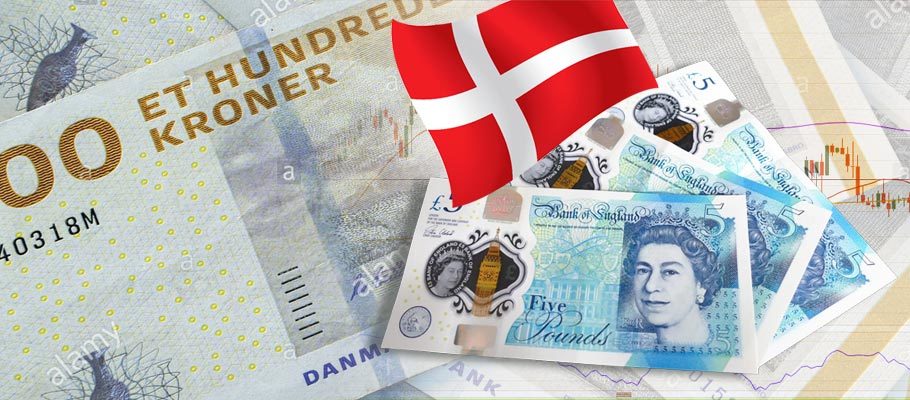
Published: July 31st, 2020
The krone (DKK) pipped higher today after the release of Danish retail numbers that saw June sales rise from 5.19 per cent to 6.5 per cent. Investors responded by signalling optimism about DKK on hopes that Denmark’s economy is moving back to a growth footing as conditions slowly return to normal.
At one point early in the week the pound to krone exchange rate (GBP/DKK) dropped by -0.2 per cent, trading in the vicinity of 8.146kr.
Adding to overall positive sentiment was news that the country is preparing to further ease COVID-19 restrictions on travel and commerce, leaving many DKK traders hopeful that Denmark is ready to leap ahead of other European economies.
Many Danish businesses that had been forced to close or severely restrict activity are now gearing up for potential re-opening as early as August.
Perhaps keeping a lid on the optimism are reports that countries in the Nordic region still face prolonged economic challenges post-lockdown. With so much disruption caused by coronavirus pandemic, forex traders are striking an optimistic-but-cautious tone.
Economists at Copenhagen-based SEB bank warned this week that despite being seen as having the outbreak under control, many European countries and business sectors are still operating in an environment of extreme uncertainty.
With its dependence on global supply chains and economic flows, any recovery in the Nordics will depend on how quickly the U.S, Asia and Europe return to commercial vitality.
Sterling’s struggles against DKK also came down to the lack of recent British economic data and the ongoing concerns over Brexit and the shape of the final exit agreement from the EU.
The pound did find some support at mid-week when the EU’s Chief Brexit Negotiator, Michel Barnier, re-affirmed that a favourable UK-European Union deal remains a possibility.
Analysts said that the Barnier had expressed confidence in closed-door meetings with EU member state representatives that a new deal with Britain was beginning to shape-up.
His upbeat comments stood in sharp contrast with the gloomy assessment he made last month when the rigid positions coming out of Westminster about ‘level playing field’ guarantees of fair competition, and restrictions on fisheries suggested a deal was far from imminent.
Currency traders are remaining cautious about GBP as a result, and Brexit uncertainties are only part of the picture. The British government’s uneven handling of the coronavirus pandemic and stop-start easing of lockdown provisions threaten to push the British economy into negative growth.
GBP traders will be watching for the UK’s July CBI Distributive Trades Survey figures. Forecasts have suggested a plunge of ca. -25 per cent, which could push GBP down further against DKK.
Krone traders meanwhile are looking forward to release of Denmark’s June unemployment statistics. A sharp rise in joblessness could chip away at DKKs recent gains.
It’s expected that GBP/DKK rates will continue to be subject to Brexit developments in the near term. Any signs of a looming accord between the EU and Britain would undoubtedly be positive for Sterling.
Back in March, the Danish central bank dismissed speculation as the cause of a dip in the currency after the coronavirus pandemic hit.
The bank said pressure on the krone had been unusually intense in the first quarter. Still, it was not impacted by excessive currency speculation or rumours of an impending change to Denmark’s fixed exchange rate policy.
Central bankers blamed the dip on Danish institutional investors selling DKK en masse after seeing a reduction in the value of their foreign assets. A corresponding decrease in currency hedges was adopted by many. The plunge in dollar hedging, for example, caused krone sales of more than 60 billion kroner (ca. 9 billion USD).
The krone is pegged to the euro, though Denmark’s commitment to this cornerstone of its monetary policy is sometimes tested. Back in 2015, the central bank was forced to conduct extensive measures to protect krone, making its biggest currency interventions in more than a decade to counter the currency’s weakening.
A decision by the Swiss central bank to reduce its Franc cap had given the krone a battering. In response, the Danish central bank drove through four successive rate cuts in short order, triggering rumours that it might be done with the decades-old Euro peg.
In April, at the height of the pandemic, the Danish central bank predicted the country's economy would contract by as much as 10 per cent.
Bank officials were quick, however, to counter concerns that Denmark might resort to quantitative easing or other non-traditional measures to keep krone – and the economy –afloat. Applying those sorts of monetary measures could have put the DKK’s euro peg at risk.
Instead, loan facilities were offered to the country’s banks while the central bank closely monitored Denmark’s covered bond market. In June the bank said it was seeing evidence of stabilization.
Bank Governor Lars Rohde told reporters in April that the bank was taking strong measures to help get the economy back on its feet and prepare for the day when the pandemic subsides, ‘but there will be pain before we get there.’
Denmark led other European countries in its fast response to the coronavirus outbreak. It quickly shut schools, cafes, and restaurants; and was one of the first EU countries to shut its borders to stop the virus’ spread. To help businesses deal with lost revenues, the government unveiled emergency stimulus equivalent to USD 40 billion.
In June, there were already encouraging signs that the approach was working. Prime Minister Mette Frederiksen told reporters that Denmark would soon begin a phased transition back to normal. Frederiksen has been widely praised for her swift and decisive response to the crisis.